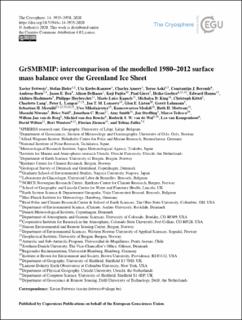GrSMBMIP: intercomparison of the modelled 1980-2012 surface mass balance over the Greenland Ice Sheet
| dc.contributor.author | Fettweis, Xavier | |
| dc.contributor.author | Hofer, Stefan | |
| dc.contributor.author | Krebs-Kanzow, Uta | |
| dc.contributor.author | Amory, Charles | |
| dc.contributor.author | Aoki, Teruo | |
| dc.contributor.author | Berends, Constantijn J. | |
| dc.contributor.author | Born, Andreas | |
| dc.contributor.author | Box, Jason E. | |
| dc.contributor.author | Delhasse, Alison | |
| dc.contributor.author | Fujita, Koji | |
| dc.contributor.author | Gierz, Paul | |
| dc.contributor.author | Goelzer, Heiko | |
| dc.contributor.author | Hanna, Edward | |
| dc.contributor.author | Hashimoto, Akihiro | |
| dc.contributor.author | Huybrechts, Philippe | |
| dc.contributor.author | Kapsch, Marie-Luise | |
| dc.contributor.author | King, Michaela D. | |
| dc.contributor.author | Kittel, Christoph | |
| dc.contributor.author | Lang, Charlotte | |
| dc.contributor.author | Langen, Peter L. | |
| dc.contributor.author | Lenaerts, Jan T.M. | |
| dc.contributor.author | Liston, Glen E. | |
| dc.contributor.author | Lohmann, Gerrit | |
| dc.contributor.author | Mernild, Jacob Sebastian Haugaard | |
| dc.contributor.author | Mikolajewicz, Uwe | |
| dc.contributor.author | Modali, Kameswarrao | |
| dc.contributor.author | Mottram, Ruth H. | |
| dc.contributor.author | Niwano, Masashi | |
| dc.contributor.author | Noël, Brice | |
| dc.contributor.author | Ryan, Jonathan C. | |
| dc.contributor.author | Smith, Amy | |
| dc.contributor.author | Streffing, Jan | |
| dc.contributor.author | Tedesco, Marco | |
| dc.contributor.author | Van de Berg, Willem Jan | |
| dc.contributor.author | Van den Broeke, Michiel | |
| dc.contributor.author | Van de Wal, Rodecrick S. | |
| dc.contributor.author | Von Kampenhout, Leo | |
| dc.contributor.author | Wilton, David | |
| dc.contributor.author | Wouters, Bert | |
| dc.contributor.author | Ziemen, Florian | |
| dc.contributor.author | Zolles, Tobias | |
| dc.date.accessioned | 2020-12-16T10:14:57Z | |
| dc.date.available | 2020-12-16T10:14:57Z | |
| dc.date.created | 2020-11-16T09:31:28Z | |
| dc.date.issued | 2020 | |
| dc.identifier.citation | The Cryosphere. 2020, 14 3935-3958. | en_US |
| dc.identifier.issn | 1994-0416 | |
| dc.identifier.uri | https://hdl.handle.net/11250/2719762 | |
| dc.description.abstract | Observations and models agree that the Greenland Ice Sheet (GrIS) surface mass balance (SMB) has decreased since the end of the 1990s due to an increase in meltwater runoff and that this trend will accelerate in the future. However, large uncertainties remain, partly due to different approaches for modelling the GrIS SMB, which have to weigh physical complexity or low computing time, different spatial and temporal resolutions, different forcing fields, and different ice sheet topographies and extents, which collectively make an inter-comparison difficult. Our GrIS SMB model intercomparison project (GrSMBMIP) aims to refine these uncertainties by intercomparing 13 models of four types which were forced with the same ERA-Interim reanalysis forcing fields, except for two global models. We interpolate all modelled SMB fields onto a common ice sheet mask at 1 km horizontal resolution for the period 1980–2012 and score the outputs against (1) SMB estimates from a combination of gravimetric remote sensing data from GRACE and measured ice discharge; (2) ice cores, snow pits and in situ SMB observations; and (3) remotely sensed bare ice extent from MODerate-resolution Imaging Spectroradiometer (MODIS). Spatially, the largest spread among models can be found around the margins of the ice sheet, highlighting model deficiencies in an accurate representation of the GrIS ablation zone extent and processes related to surface melt and runoff. Overall, polar regional climate models (RCMs) perform the best compared to observations, in particular for simulating precipitation patterns. However, other simpler and faster models have biases of the same order as RCMs compared with observations and therefore remain useful tools for long-term simulations or coupling with ice sheet models. Finally, it is interesting to note that the ensemble mean of the 13 models produces the best estimate of the present-day SMB relative to observations, suggesting that biases are not systematic among models and that this ensemble estimate can be used as a reference for current climate when carrying out future model developments. However, a higher density of in situ SMB observations is required, especially in the south-east accumulation zone, where the model spread can reach 2 m w.e. yr−1 due to large discrepancies in modelled snowfall accumulation. | |
| dc.language.iso | eng | en_US |
| dc.rights | CC BY 4.0 | |
| dc.rights.uri | https://creativecommons.org/licenses/by/4.0/ | |
| dc.title | GrSMBMIP: intercomparison of the modelled 1980-2012 surface mass balance over the Greenland Ice Sheet | en_US |
| dc.type | Peer reviewed | en_US |
| dc.type | Journal article | en_US |
| dc.rights.holder | © 2020, Authors | |
| dc.description.version | publishedVersion | |
| cristin.ispublished | true | |
| cristin.fulltext | original | |
| cristin.qualitycode | 2 | |
| dc.identifier.doi | 10.5194/tc-14-3935-2020 | |
| dc.identifier.cristin | 1848186 | |
| dc.source.journal | The Cryosphere | en_US |
| dc.source.volume | 14 | en_US |
| dc.source.pagenumber | 3935-3958 | en_US |

